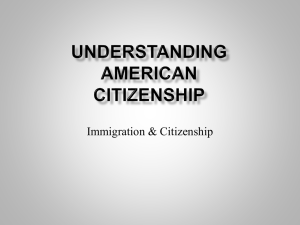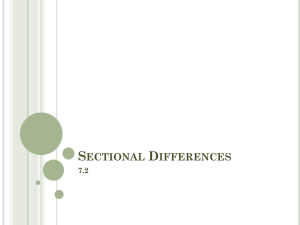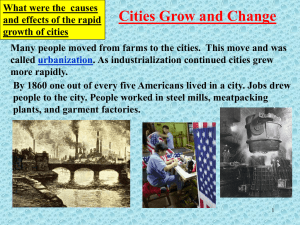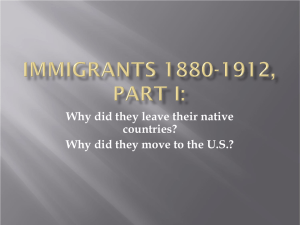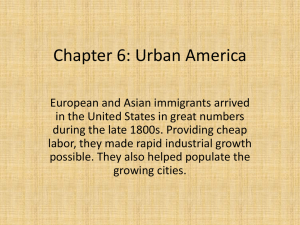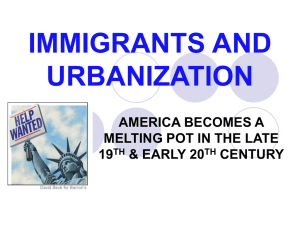Chapter 15 Immigrants and Urbanization
advertisement
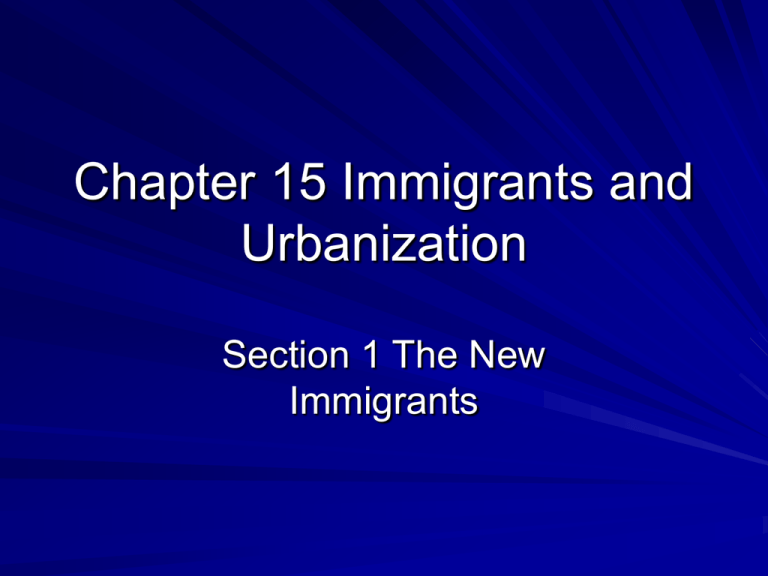
Chapter 15 Immigrants and Urbanization Section 1 The New Immigrants Through the Golden Door Millions of immigrants entered the U.S. in the late 19th and early 20th centuries because they were lured by the promise of a better life. Immigrants from Europe -from 1870-1920 approximately 20 million Europeans arrived. -Immigrants from China and Japan – They came to the West coast. – Between 1851-1883 200,000 Chinese arrived. – Many came to seek their fortunes after the discovery of gold in 1848 sparked the California gold rush. Immigrants Immigrants from the West Indies and Mexico - Between 1880-1920 about 260,000 immigrants arrived in the Eastern and Southeastern U.S. - Some Mexicans came to find work or to flee political turmoil. Life in the New Land - The journey was difficult. - Almost all immigrants traveled from steamship. - The trip from Europe took one week. - Immigrants were rarely allowed on the main deck. - No fresh air, lice infested, crowded, diseases spread. Life in the New Land Ellis Island (Europeans) – In the New York Harbor – Immigrants faced loneliness, homesickness and anxiety. – About 20 % of those who arrived, were retained for a day or more before being inspected. – 2% had to return home. – Had to pass a physical, passing a literacy test in their native language, proof of ability to work and have at least $25.00 on them. – More than 16 mil. passed Angel Island (Asians) – Located on the West Coast in San Francisco Bay. – Between 1910-1940 about 500,000 Chinese immigrants entered the U.S. through the island. – Here conditions were harsher. – There was harsh questioning, long detention while govt. officials decided whether to admit or reject an immigrant – There was a protest in 1919. – The Chinese immigrants were confined like prisoners. Immigration Culture Shock – Confusion and anxiety from immersion in a different culture Cooperation for Survival Immigration Restrictions Melting Pot – A mixture of people of different cultures and races Rise of Nativism – A response to the growing numbers of immigrants in the U.S. – It gained support as suspicion and fear of foreigners grew. Anti-Asian Sentiment – Prejudice against Asians was first directed against the Chinese – The depression of 1873 intensified it in California – Jobs were scarce and there was fear that work would go to the Chinese because they were willing to work for low wages. – Chinese Exclusion Act – The Gentlemen’s Agreement 15.2 The Problems of Urbanization Urban Opportunities Urbanization Immigrants settle in the Cities – The people who came became city dwellers, because cities were the cheapest to live in. – Immigrants often clustered in ethnic neighborhoods with others from the same countryor even the same village. Migration from Country to City Farming more efficient, less laborers needed. Urban Cultural Opportunities Urban Problems – Housing As the urban population increased , new types of housing were designed – Row Houses Attached single –family dwellings that shared side walls with other similar houses, packed blocks. – Dumbbell tenements Long narrow, 5 or 6 story buildings shaped like barbells. Urban Problems Transportation – Getting around the city safely and efficiently was a problem. – Before industrialization people went on foot or by horse drawn vehicles. Cable cars in 1873 Electric streetcar line Water – Supplying fresh water that was safe to drink. – Large cities like NYC seldom had indoor plumbing. – Diseases – Chlorination introduced in 1893 and filtration in 1908 Sanitation – Keeping the cities clean became a challenge. – Private trash collectors were hired to sweep the streets. – Sewer lines and sanitation departments were in cities by 1900. Fire – Since there was limited water in cities, it contributed to the spread of fires. – In San Francisco deadly fires would breakout after earthquakes. Crime – As population rose, so did crime. – Pickpockets, clever scams, gangs. – First full time salaried police force in NYC in 1844. Reformers Mobilize Social Gospel Movement – Social welfare reformers targeted efforts at relieving the poverty of immigrants and other city dwellers. – This movement preached salvation through service to the poor. Settlement-House Movement – Inspired by the Social Gospel movement, this movement was a response to the call to help the urban poor. – In late 1800s, a few reformers established settlement houses, which were community centers in local slum neighborhoods that provided assistance and friendship to local men women and children especially immigrants. – Jane Adams founded Chicago’s Hull House in 1889. 15.3 The Emergence of the Political Machine The Political Machine – Was an organized group that controlled activities of a political party in a city an offered services to voters and businesses in exchange for political or financial support – Organized like a pyramid. – At the base were workers. – Precinct captains, ward bosses, and the city boss worked together to elect their candidate and guarantee the success of the machine. The Role of the Political Boss – The city boss controlled thousands of municipal jobs, including those in the police, fire and sanitation departments. – $$$ gave the city bosses the drive to deal with urban issues. – When they solved problems, they won people’s loyalty which in turn was political support and votes. Immigrants and the Political Machine – They received sympathetic understanding form the machines an in turn became loyal supporters. – Many political bosses were first or second generation immigrants. – Bosses provided solutions. Municipal Graft and Scandal Election Fraud and Graft – Political machines and voters were not the only things necessary to carry an election so they turned to fraud. – Once a political machine got its candidates in office, it took advantage of opportunities for graft. – Ex. of graft is a political machine would ask a construction worker who is working for the city to turn in a bill that is higher than the actual cost . – Kickbacks were illegal payments for services made by political machines. – Taking these kickbacks made individual politicians very wealthy. – Pol. Machines made $ by granting favors to businesses in return 4 $. The Tweed Ring Scandal – – – William Macy Tweed, one of the earliest and most powerful bosses, became head of Tammany Hall He became head of Tammany Hall which was New York City’s powerful democratic political machine, 1868. Between 1869-1871, the Tweed Ring , which was a group of corrupt politicians led by Boss Tweed, pocketed as much as 200 million dollars from the city in kickbacks and payoffs.

